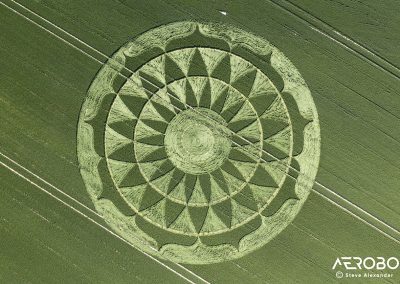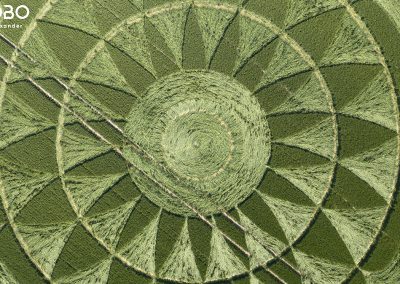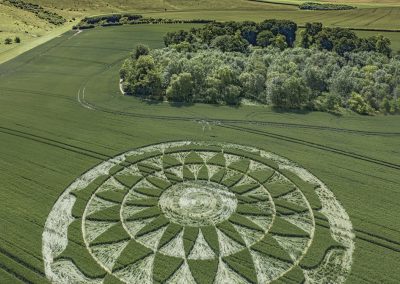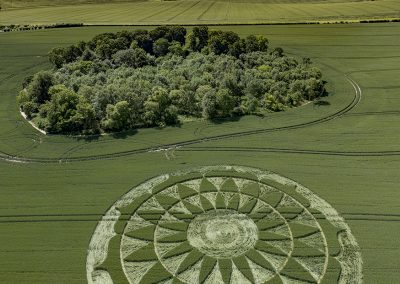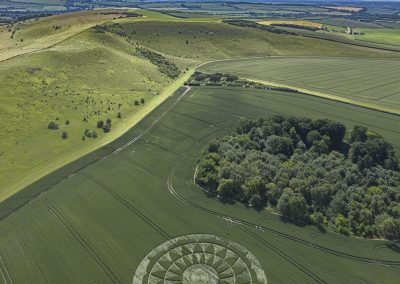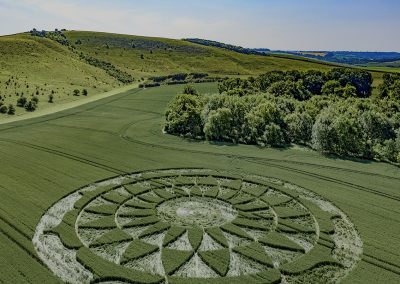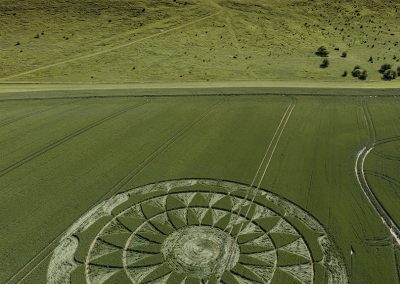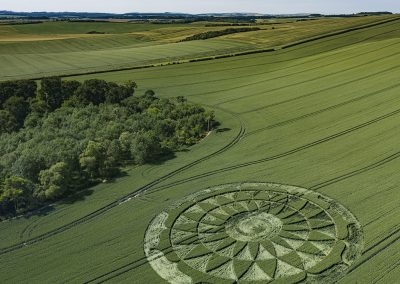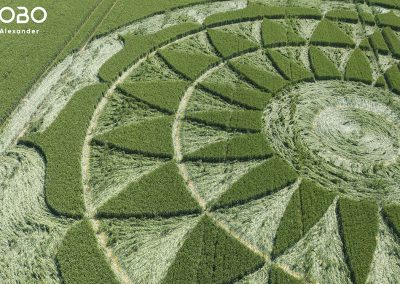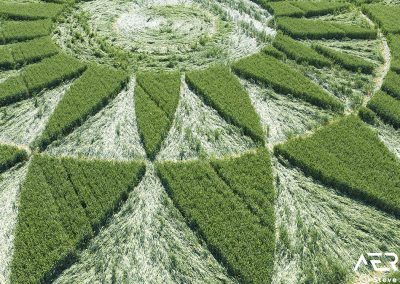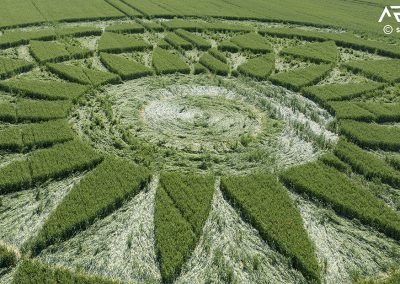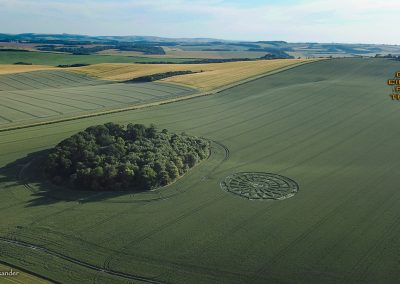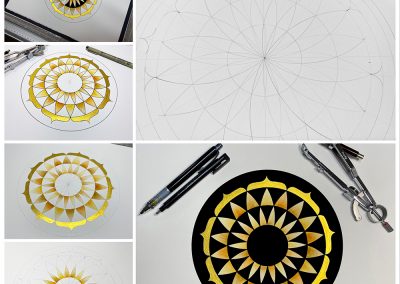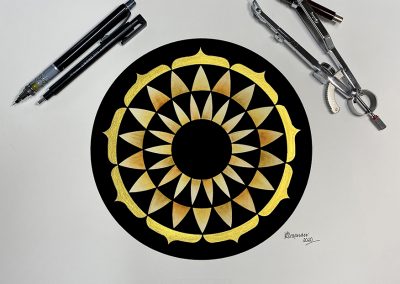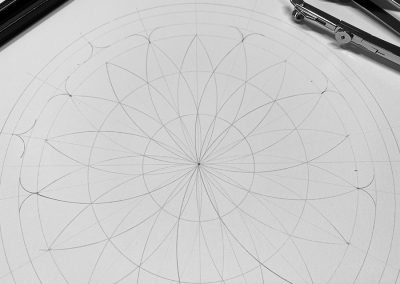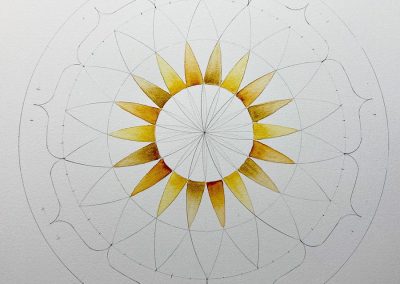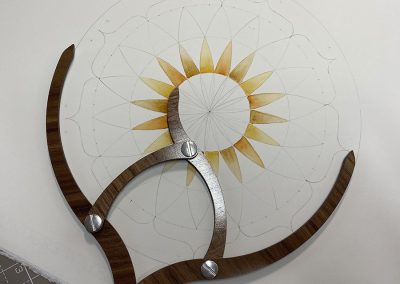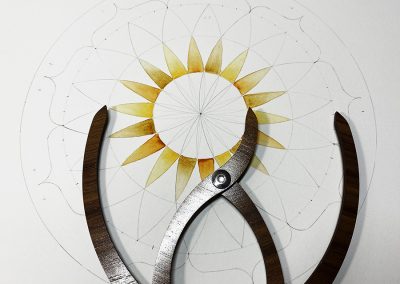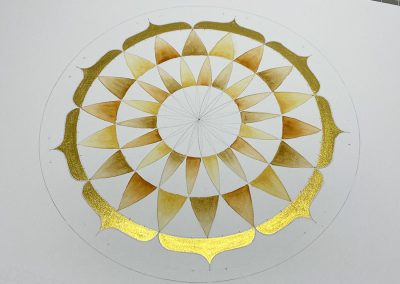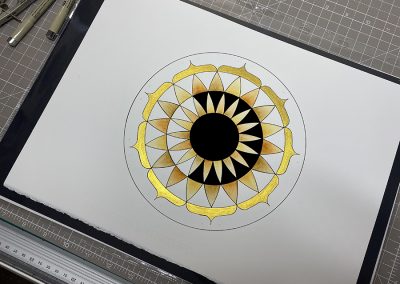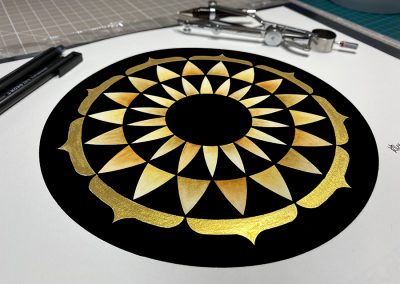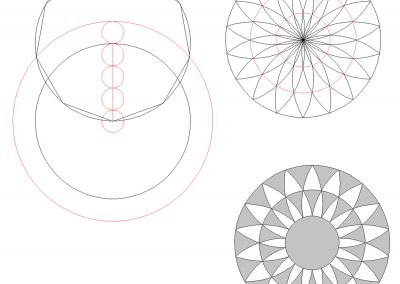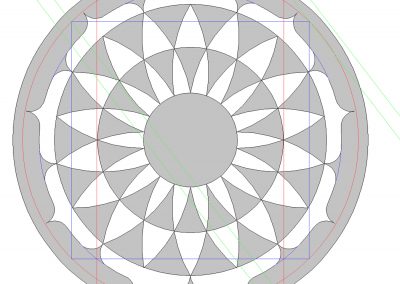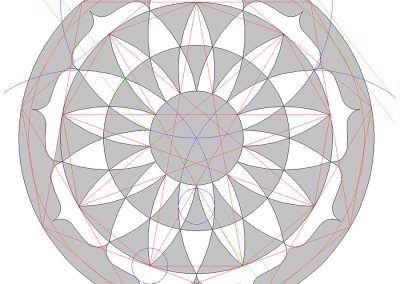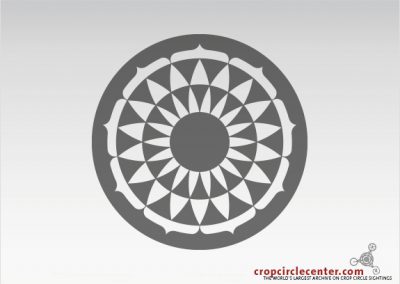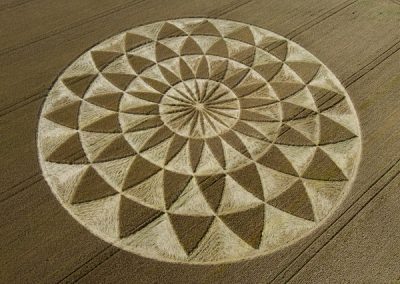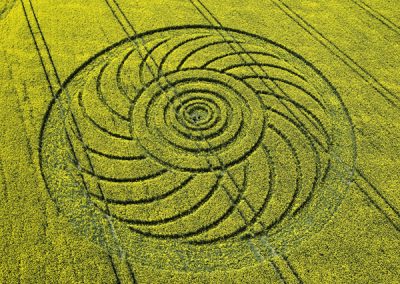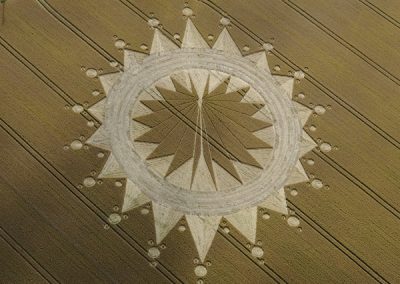Smeathe’s Plantation, Ogbourne St. George, Wilts.
(North of Marlborough)
Detail & Location: This circle was reported on the 25th of June. It is in a field of green wheat and measures approximately 250ft in diameter. See the Google Maps link for precise location. It is the most accomplished formation of the 2020 season so far.
This crop circle has unfortunately been cut out by the farmer.
Crop Circle Reporting and Covid-19: After considerable thought and consultation, we have decided we will not be censoring crop circle locations during the Covid-19 pandemic. There are no current restrictions in place in the UK that call for a blanket ban on visiting the countryside. We consider the reporting of crop circles to be in the spirit of journalism, and censorship to be an anathema to that spirit. Therefore, we will be treating the crop circle community as adults and asking everyone to approach the information carefully and responsibly. This will include not visiting the circles if the farmer has not given explicit permission to do so and should permission be given that they practice social distancing by staying 2 metres away from fellow visitors. It would be our very strong advice that visiting the crop circles on the ground should be kept to an absolute minimum for now. However, because we know that the location of any given circle can be important to researchers and those that record the circles from the air, we will continue to share what we know.
Flying during the Covid-19 Pandemic: As yet, because of the current pandemic, we have not been able to take to the air to record the crop circles as we usually would. We are however, very confident that the restrictions keeping us grounded at present will be lifted before too long and we will be able to cover the rest of the season as usual. In the meantime, we are every pleased to have teamed up with the excellent AEROBO (Art in Flight) who will be helping us collect images and drone footage of the latest crop circles to share on the website.
Visiting: As far as we are aware no permission has been given to visit this crop circle. Please do not visit this circle. Thank you.
History & Connections: Coming soon…
Design & Symbolism: See the geometry galley below for some initial thoughts.
Visiting the Circles? If you are thinking of visiting any crop circles this summer, please read our Visiting the Crop Circles section. It’s full of useful information and etiquette for visiting the countryside and the crop circles. Please remember that you should not enter any fields without the express permission of the farmer and you will need to be aware of and abide by any restrictions in place in the UK in response to the Covid-19 pandemic.
Click here for Copyright Information about the reproduction of images on this website.
Please Help to keep us Flying in 2019: If you have enjoyed looking at our pictures and information please consider making a small donation to keep us flying. There are so few of us left regularly recording the circles it’s really important that we continue. And while some now use drones to record the circles, it is important that there are still images taken from aircraft where the best quality camera equipment can be used and images that include the broad vista of the landscape can be taken. This kind of photography is expensive and it gets harder with each passing year to raise the funds we need to continue our work, but if everyone who regularly looked at this website made a small donation we would meet the funds we need. You can make a donation here.
NOTE: Some of the images below are beautiful landscape scenes. Click on each image to enlarge them and see the whole picture.
We would like to say a huge thanks to Hugh Newman for allowing us to use his image of this crop circle in our gallery below. You can see more of Hugh’s work at his YouTube channel Crop Circles from the Air and his Facebook Page of the same name.
Image Licencing
We can supply high resolution images of many of our photographs and the sky is the limit as to what they can be used for! Choose from our extensive library or contact us to commission aerial photography for your project.
Geometry Gallery
The Crisis before reaching Maturity
The relationship between 9 and 18.
By Karen Alexander
The Question of 18?
This crop circle has a curious 18-fold geometry. I say curious because 18 is a number that doesn't sit in the decad or duodecad (obviously), yet has been offered to us many times by the circle-makers over the years, so it must have some significance, or convey something that is important that we see or hear.
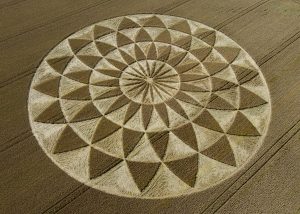
Martinsell Hill, Nr Oare, Wilts | 19th July 2007
This new formation was very reminiscent of a circle that occurred back in 2007 at Martinsell Hill, near Oare in Wiltshire. It had a very similar 18-fold geometry. See the gallery below for a couple of other 18-fold designs from our archive.
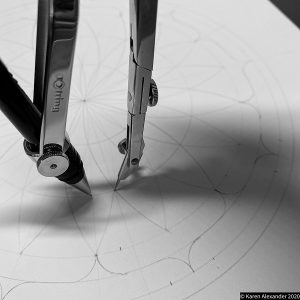
The circle used to create the curves in the lotus petal is taken directly from the geometry of the 18-fold flower
On the drawing board, the 360º of the circle is divided into eighteen 20º sectors to create the flower at the centre of the design. Concentric circles are placed at the two natural points of intersection of those petals in the underlying pattern, they create the centre circle and the next two circles working from the centre outwards.
Taking proportions from elements already established in the design is a time-honoured feature of traditional Sacred Geometry, everything is generated from within, it keeps the patterns natural and well balanced. It also is symbolic of the nature of creation, where everything is related and generated from a single source - the Godhead.
The 18-fold flower is then locked into place by nine lotus-type petals, each of the lotus petals holds two petal points of the 18-fold flower and a third marks the intersections between the none lotus petals. There is a sense of wholeness here, with numbers and intersections clicking right into place.

The petals of the lotus - the lotus of the sacral chakra
The Petals of the traditional Lotus?
I don't think I have seen lotus petals in crop circle design before. You often see them in the lotus-flower icons given to each of the chakras, this gives the entire formation a distinctly mandala-like quality. Comparisons have often been made between crop circles and mandalas, in this case the comparison holds considerable symbolic weight.
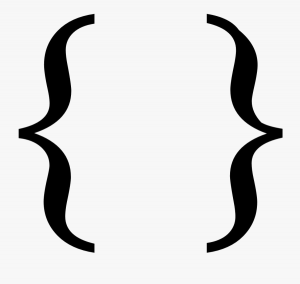
Curly brackets used in relation to numbers rather than grammar
Curly Brackets?
This would not be the only interpretation for these shapes. As they are also reminiscent of 'curly brackets' which are most often used in mathematics (rather than grammar), to group together numbers or equations. In the context of this circle being geometry and number incarnate, this also feels like a legitimate interpretation.The two do not have to be mutually exclusive, crop circles are nothing if not multivalent! To bracket something is to group together, to draw attention to, the connectedness of something.
The Relationship between 18 and 9
It would be very easy, when looking at this circle to disregard its eighteen-ness and look to the 9 lotus-type petals, but I think that would be to ignore the obvious and what is being explicitly proffered. Nine is part of the archetypal decad of numbers and is much easier to interpret, but 18 (while related) is something different altogether.
Wolfgang Held, in his book 'The Quality of Numbers 1 - 31', points out that eighteen is a number denoting maturity. It is the age at which human beings are considered to have reached adulthood in many cultures. It is the point of initiation, the point at which full responsibility is transferred and entrusted to us.
Nine is also a pivotal number - the number of threshold. It is perhaps best exemplified by its connection to the maturation of the human foetus which takes nine months of pregnancy to achieve. The human foetus has to cross the threshold of the birth canal in order to become a fully realised human infant. Nine is also known as the almost perfect number for the same reason; it stands at that point of transition, or pure potential where we may pause, but where moving on to something new is in an inevitability.
For this reason nine is also a number of crisis. At the point of the beginning of the trial of labour, the foetus will face its greatest jeopardy in order to be born - a successful pregnancy is not concluded until a live birth is achieved.
The relationship between 9 and 18 can be understood as the crisis before reaching maturity. It is yet another expression of the nature of transformation expressed by the crop circle phenomenon. No transformation comes without risk or jeopardy of some kind. Yet the symbolism of the flower is a hopeful one, the gentle nature of the flower, its beauty and elegance - its humility is a powerful image.
The Archetype of the Age?
There is no doubt that mankind is at a moment of crisis on many, many levels as it strives for maturity and transformation. This formation seems to be reflecting the awesome power of the 'archetype of the age'. It is a Mandala that demands some serious contemplation. I found it to be deeply, deeply moving.
Thanks & Credits
This article would not have been possible without the generous help of a handful of very important people. I would like to thank some of my crop circle cognoscenti for their help in forming these ideas: Steve Alexander, Peter van den Burg and Geoff Fitzpatrick
Text | Hand-drawn Images by Karen Alexander.
With special thanks to Peter van de Burg for his thoughts, perspectives and analysis. You can see more of his great work on his Facebook page Geometry of the crop circles.
Golden Section Proportioners by Scott Onstott.
Diagram by Bertold Zugelder.
Further Thoughts:
By Peter van den Burg
I don't think I am finished with this formation just yet. A formation with such clear cultural reference deserves more attention. But these things will come at the apropriate time. The geometrical aspects are quite possibly the easy part.
A nonagon cannot be constructed without measuring. Only aproximately. This one can be constructed as follows; construct a circle with radius seven. Make a Vesica pisces from that circle, make another circle with radius nine. This will give you the aproximate angle for a nonagon. Double it to make an eighteen fold.
The petals make a Squared circle, while a Golden rectangle determines the central circle with the perimeter circle. The square and rectangle bind the two parts together.
The third drawing may not be very clear but shows the formation in nonagonal, or ninefold geometry. It shows also how the eighteen petals in the central part are made from six triquetra's
Lovely lay in the centre. It was noticed but not taken into account in this reconstruction.
See Peter's reconstructions in the gallery below.


